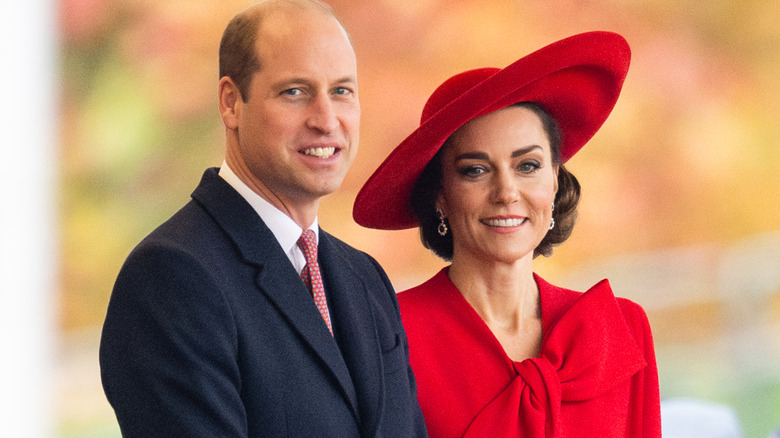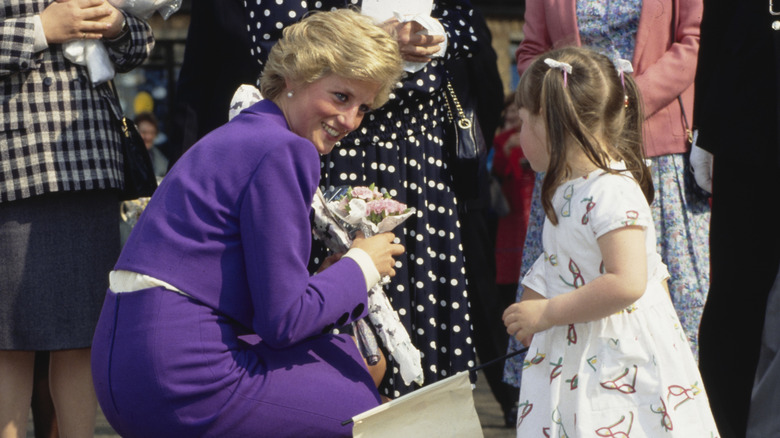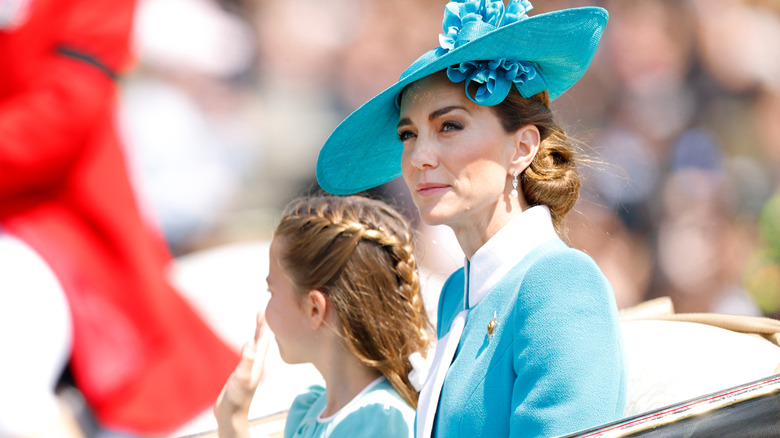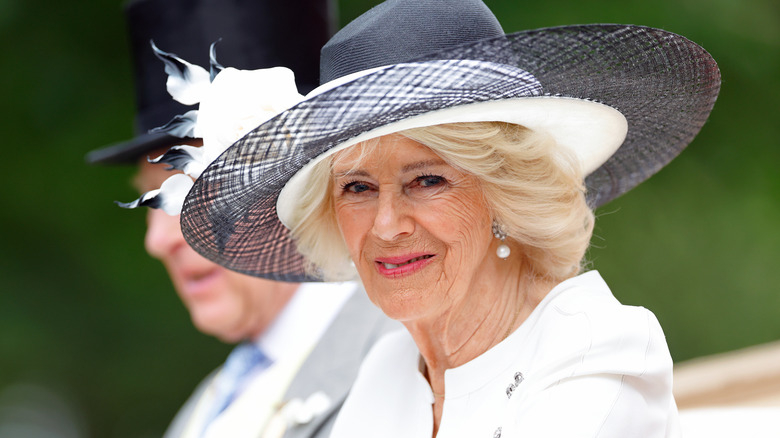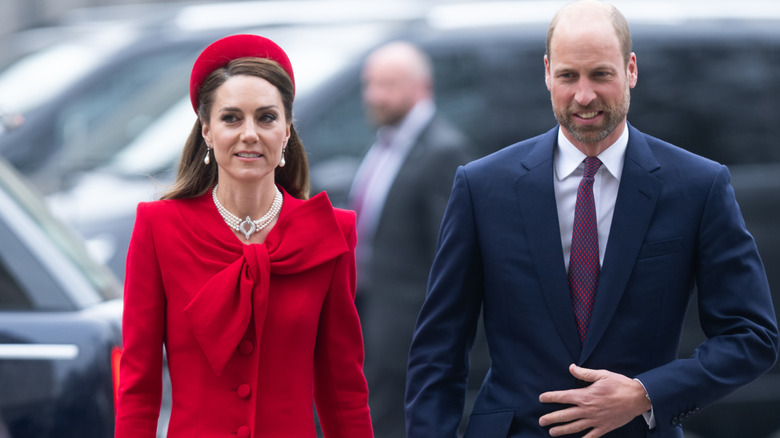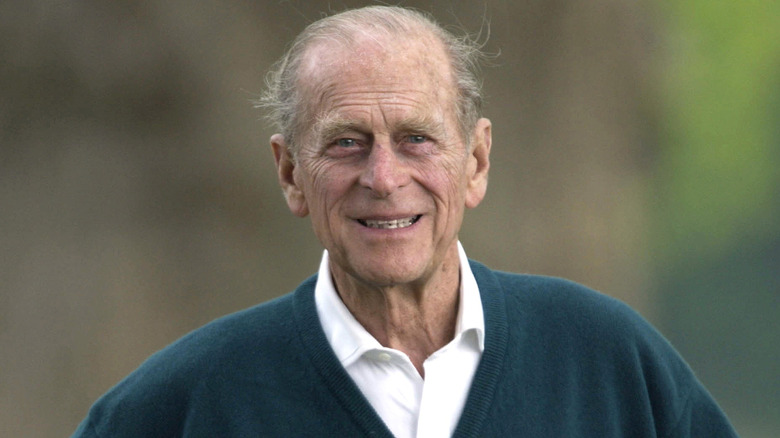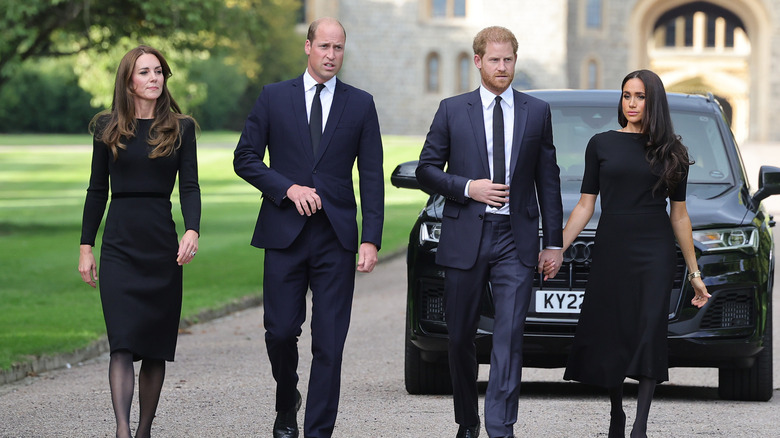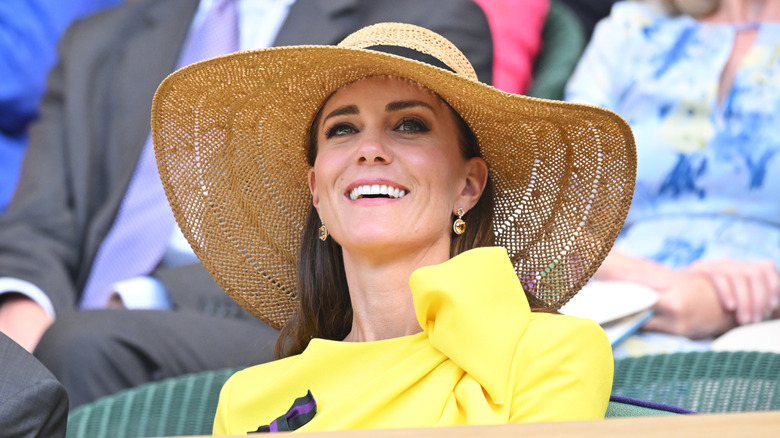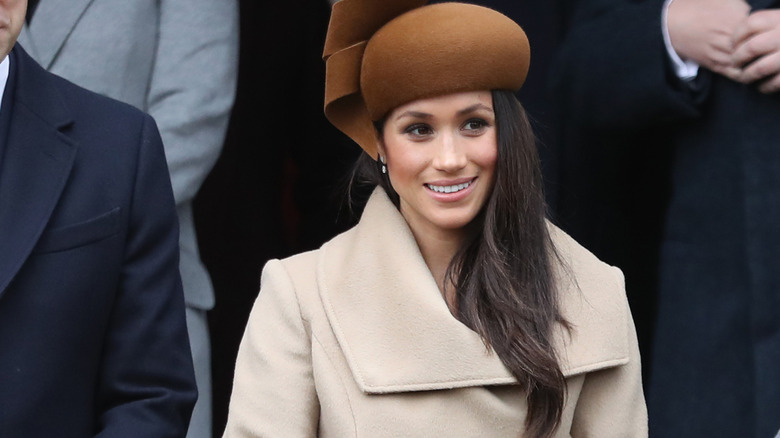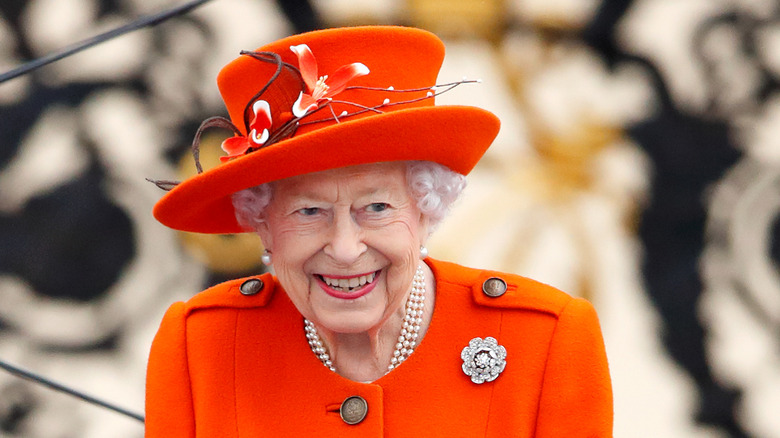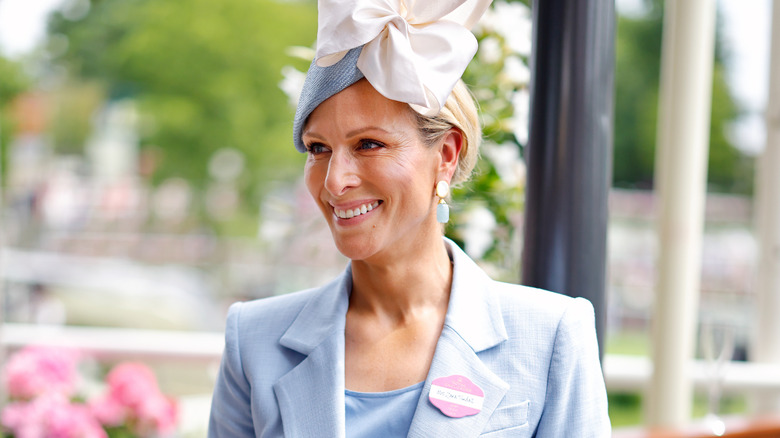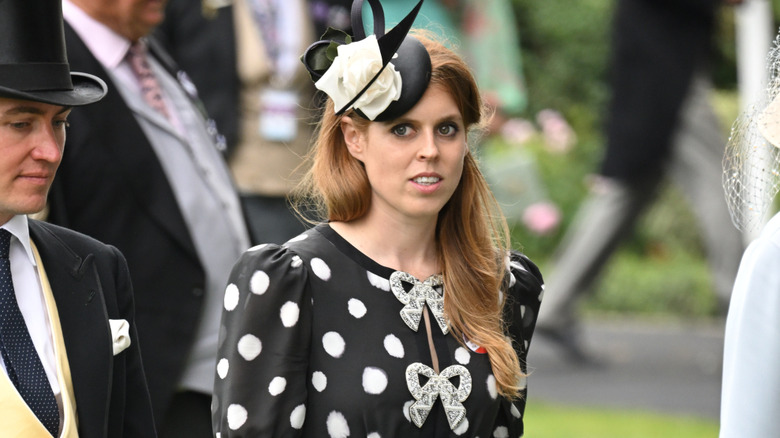What It Really Means When Royals Wear Certain Colors
British royals don't grace runways or pose for magazine shoots, but the world looks to them for fashion. The Windsors have been stunning with their style for over a century, exploring what seems like the full extent of the color spectrum with their eye-grabbing outfits. What we often don't realize is that their sartorial choices, in particular the colors they wear, are hardly ever random. Color is a silent language people in positions of power have always spoken; a lovely looking blue or a cheerful yellow aren't all they seem to be. More often than not, even the most innocuous looking royal outfits carry centuries of symbolism and deliberate messaging.
Though some color traditions are deeply rooted in the history of the British aristocracy — such as white gowns at weddings and all-black uniforms at funerals — others draw meaning from branches of psychology and color theory. The metaphors behind many colors, like red for power or blue for trust, are therefore universal and not exclusive to the monarchy. However, those very colors become important symbols of power and diplomacy in the royal context. Interestingly, these color-coded communications from the royal palace have evolved significantly over the years. We spoke to two royal experts to understand more on the subject: Amanda Matta, royal commentator and founder of The Fascinator, and Brittany Provance, editor-in-chief at Royal News Network. Scroll on to learn what it really means when royals wear certain colors.
Purple holds the crown when it comes to royal colors
The significance of the color purple cannot be overstated in the royal context. From coronations to Commonwealth events, the hue dominates the imagery of many ceremonial events in the monarchical tradition, so much so that it enjoys an exclusive reputation as a royal color. Its status holds historical weight that goes back centuries, when purple dye — especially Tyrian purple or royal purple — was expensive to make. According to BBC, the pigment at one point in history surpassed gold in value. Its distribution was therefore limited to the aristocracy and upper classes. In fact, it is believed that during her reign, Queen Elizabeth I forbade people outside the royal family from wearing the shade.
As social customs around royal dressing eased out and fashion choices came into play, purple became just another color on the vast spectrum modern leaders could choose from. "There's a lot of personal preference that goes into royal dressing, though obviously keeping it in line with the general royal dress code," Provance elaborates. That Queen Elizabeth II opted for purple repeatedly during her tenure can be read as a statement on both her authority and liking. The same can possibly be said for two more purple aficionados: Princess Diana and Queen Camilla. Interestingly, Princess Catherine hasn't indulged in the color too much, although her turnout in a purple dress at 2024 Wimbledon was enough to make a world of impact.
Blue signifies trust and reliability
There is something instantly agreeable about blue that goes beyond just the appeal of the color's beauty. The British monarchy recognizes this quality more than we probably realize, with blue showing up as a regular feature across royal wardrobes. Prince William and Princess Catherine's family of five, in fact, repeats the shade so much that it has evolved into something more symbolic than just a preferred color — "almost like a branding tool," according to Matta. "We see that clearly in the Wales family, which has embraced blue as their signature ... it's not disruptive, and it quietly commands respect."
Across discourse on color theory and psychology, blue holds largely positive connotations that range from calmness to loyalty and credibility — all significant to the office of a royal. This acknowledgment isn't limited to the Wales family; it is appreciated even in the topmost ranks of the royal hierarchy. Queen Camilla seems to have embraced the color, in particular the derivative (and rather fitting) shade of royal blue, since being crowned in 2023. Whether she's posing for royal portraits or meeting various heads of state in royal blue dresses, her inclination toward the color is evident. In fact, Matta says there have reportedly been instances of other royal women being discouraged from donning the same color, consistent with the royal protocol of not matching with the monarch. As she puts it: "Color coordination can reflect family unity, but it can also reinforce the pecking order."
White is a symbol of purity
The metaphor white stands for needs little introduction. Used universally as a message of peace, purity, and all-around good virtue, it makes an impact without any hues. Royals have make good use out of the righteous quality of white, by embedding it deep into the culture of the monarchy and wearing it ceremonially to milestone events. For King Charles III's coronation, for instance, many women across the royal order were decked in white. The symbolism of the color as it correlates to new beginnings was on vivid display here.
Weddings, of course, are another major exhibition of the importance of white in all its glory. In fact, like so many other style trends that came straight from the royal family, the tradition of white bridal dresses goes back to Queen Victoria, who is historically credited with setting the precedent at her 1840 wedding to Prince Albert. Over centuries, the meanings attached to white weddings have evolved to indicate a pure, virginal quality that extends largely to the bride.
Beyond its ceremonial value, white has also been at the center of some of the best fashion statements royals have ever made. It's a summertime go-to color of Princess Catherine, whose plethora of white dresses have wowed royal watchers for years. And who can ever forget her mother-in-law Princess Diana's bejeweled white "Elvis" dress, which she paired with her favorite Cambridge Lover's Knot Tiara during a visit to Hong Kong in 1989.
Royal women wear red for power when they can
Red carries an in-your-face boldness that not everyone can pull off. Many within the British monarchy can, though, and in style. Queen Camilla, Princess Catherine, and even nonworking royals like Princess Eugenie have been spotted wearing the fiery shade across formal engagements and more casual outings. In popular culture, red has long signified themes of passion and emotion. But a reading of it that is probably more relevant to those who reign over a population is that it is also deeply symbolic of power. Where shades like green and blue convey a sense of authority with some sobriety, red stands out as a bright, unabashed declaration of it.
It is not a color that is worn lightly in royal circles, for a red outfit is always bound to catch the eye. For Catherine, whose appetite for the color in recent years has been rather obvious, power-dressing in red comes through as a layered choice. On certain days, it can be suited to the occasion. "Catherine may choose to wear a particular color that represents a charity or cause she is supporting," Provance explains, pointing to the Taking Action on Addiction event in 2021, where the princess' red attire coincided with the color of addiction awareness. "Royals are very conscious of what they're wearing and try to send messages with their clothes." Red is also significant to Welsh imagery, which could explain why the Princess of Wales gravitates toward it.
Green is another symbolic color
Green has been a longtime favorite of the British royal family, and not just its women. Prince Philip, easily one of the most fashionable men in the monarchy for generations, had a well-known fondness for the color, which he didn't shy away from flaunting with his dapper olive jackets, emerald sweaters, and forest green coats. He seemed to be a rare exception to the general observation that otherwise follows royal men, pointed out by Provance: "When it comes to royal fashion, the men can be a little dull most of the time."
A dark shade called Edinburgh green was especially central to Philip's life, having been the official color of his livery. So when the family gathered for his memorial service in 2022, many like Queen Elizabeth II, Princess Anne, and Queen Camilla coordinated in the shade in honor of the late royal. The moment also demonstrated the symbolism behind royals matching their outfits. As Provance explains, "It remains true that royal women do coordinate their colors and outfits at joint events to provide a cohesive front."
Interestingly, the royals seem to harmonize in green attires a lot. It happened multiple times in 2024 at major events, including the Easter service at St. George's Chapel and Christmas as Sandringham. Green shades have eternally stood for messages of rebirth, new beginnings, and harmony, which tie in seamlessly with the ever evolving royal order and its enduring balance between tradition and change.
Black is majorly for mourning periods
Few colors have the instant, classic, all-season appeal that black does. Unfortunately, the British royals are not at liberty to explore its fashion potential, because monarchical traditions dictate that black be reserved for periods of mourning. The custom can be traced back to Queen Victoria, who single-handedly popularized the symbolic connection between shades of black and themes of grief in 19th-century England by dressing in it every day for four decades straight after the death of her husband in 1861. "In the Victorian and Edwardian eras, color played into strict protocols, especially when it came to mourning," Matta explains, adding that even grays and purples were not particularly cheerful colors.
The "perpetual widow," as Victoria was called, thus set off a color-coded tradition that is honored within royal circles to this day. In recent memory, the world saw it on somber display at the funerals of Queen Elizabeth II and her husband Prince Philip. Over the years, however, the no-black rule seems to have become somewhat relaxed, for women especially. Top royals like Queen Camilla and Princess Catherine have worn the color to happier occasions like charity dinners and formal receptions. "You'll tend to notice for royals that if black is worn outside mourning, it's generally for evening events or gala events," Provance also points out. In fact, black isn't completely off-limits for daytime events too, with Camilla stepping out in the color for King Charles III's proclamation as king in 2022.
Kate Middleton loves a good yellow dress
It's nearly impossible to look at yellow and not be overtaken by a feeling of warm, sunny joy. The color is bright enough to stand out in a crowd, yet cheerful enough to connect with it. And perhaps for those very reasons, it appeals so much to royal tastes. Princess Catherine, especially, seems to have a great appetite for dressing in yellow and is frequently spotted at royal engagements and major events like Wimbledon in shades of lemon, sunshine, canary, butter, and other merry things.
"Catherine has worn a variety of colors throughout her time as a royal, but like every woman, she knows what colors look best on her and tends to stick to a particular color palette," Provance notes. Given that she makes headlines every time she dons the hue, the Princess of Wales is clearly adored in yellow. In fact, she reportedly sent sales of yellow dresses skyrocketing on eBay in 2014 during her visit to Australia, where she popped in a multitude of yellow fits — notwithstanding her quip, "William said I look like a banana" (via E! News).
Queen Elizabeth II, with her penchant for bold colors, also wore yellow often but, as Matta points out, "Her famously bright, monochromatic outfits were more than just a style choice." Neon shades like yellow were crucial to her imagery as the monarch, especially considering her short stature, so she could be picked out in a sea of people.
Some dress in neutral tones to blend in
The 2022 documentary "Harry & Meghan" called attention to a lot of intriguing details from within the palace walls, including how color affects royal imagery. In elaborating on her life within the Firm, she made a headline-grabbing confession about wearing neutral colors during her tenure as Duchess of Sussex in order to avoid claiming the spotlight over other senior members of the family. "It also was so I could just blend in. Like I'm not trying to stand out here," she said. Though Meghan's words were widely used to illustrate how dreary life could be under hierarchical royal traditions, it wasn't a fully accurate picture.
"There is nothing that prevents someone from wearing beige colors all the time as a royal," Provance tells us, adding that Meghan's claims didn't really hold weight. "Royals beyond a few stipulations, like not wearing black unless it's for mourning, are free to wear the colors that they wish. ... She continues to wear beige very consistently, seemingly acknowledging that beige was and is a personal choice and not a way to avoid clashing with the other royals."
Not just Meghan, but women across the royal order have a soft spot for neutral tones; think camels, off-whites, browns, creams that exude sophistication befitting a royal, even in the absence of eye-grabbing hues. To that end, even royal men, including King Charles III, enjoy exploring these lighter shades on occasion to break away from their boring old black suits.
Oranges are not as common
Few royals have been as courageous in experimenting with bright colors as Queen Elizabeth II was. In fact, the spunky late monarch didn't back down from even orange shades, considered by many to be high-risk territory. It's not without reason that orange is not a common feature of royal wardrobes. "There's definitely an aversion to ultra-bright tones like neons, partly because they don't photograph well and partly because they can feel too informal or trend-driven for palace settings," Matta explains.
But Elizabeth, a fashion rebel through and through, threw caution to the wind and wore variations of the color often. "Her uniform was quite boring, a coatdress and a hat, but the bright colors and accessories allowed her to stand out and gain attention in the best way," Matta added. Notorious as it may be for disrupting camera-facing appearances, orange is actually a color with positive connotations. It conveys both enthusiasm and warmth in equal measure, adding a touch of cheer to even the most drab frames.
While royal women still refrain from indulging in the color — with rare exceptions like Princess Catherine and Princess Eugenie, who have worn it on occasion — the public was more than supportive of Elizabeth's orange-tinted fashion adventures. A bright outfit she wore to the Queen's Baton Relay during the autumn of 2021 was memorably met with an overwhelming response on social media, proving that fashion risks can pay off when pulled off well.
Pastels are good for daytime events
Pastels are enjoying a major fashion moment, not just on runways but also in royal circles. It's noteworthy, not simply for the impeccable style royals are delivering with pastel palettes, but also because such light, muted shades radically challenge the general sartorial norms by which the British monarchy abides. This includes dressing in bright colors that "gain the crowd's attention, in a positive way," as Provance puts it. However, royal traditions seem to have moved well beyond their once-unyielding edicts to accommodate contemporary fashion cycles and trends that actually resonate with people. Pastels, though devoid of any inherent symbolism, do hold the power to convey a sense of serenity and lightness that can appeal to onlookers without overwhelming them.
The ever-colorful Queen Elizabeth II often switched out her otherwise blindingly neon wardrobe for paler shades of pink, green, and blue. Pastels were also a Princess Diana-approved trend, with the late royal opting for soft purples and yellows on occasion. Currently, Queen Camilla and Zara Tindall seem to be the two major flag bearers of pastels within the family, stunning in soft hues across events like Royal Ascot and royal weddings. "Muted neutrals and pastels have become much safer choices for daywear, while bold primaries or jewel tones tend to be reserved for statement moments. Again, it's all about the messaging," Matta says.
Polka dots are popular with many royals
It's hard to imagine royal style without the cheerful charm of polka dots today. It's even harder to think then that this über fashionable dotted pattern was historically disdained. Centuries ago, when the plague and other illnesses dominated Europe, the masses (understandably) had reservations about wearing patterns that resembled disease. With better machinery and precision in stitching, the narrative against polka dots eventually turned and by the time Queen Elizabeth II took office, the once-disputed design had made its way into royal wardrobes, where it has stayed ever since.
Though bolder, brighter monotones were her domain during later years, Elizabeth seemed to have had a weakness for polka dots in her youth and pulled off the design in all hues throughout her tenure — blue, yellow, purple, pink, you name it. This penchant for polka dots came to span the hierarchy, with every top royal from Princess Diana to Princess Catherine, and less-spotlighted style icons like Sophie, Duchess of Sussex, and Princess Beatrice gravitating toward it.
Polka dots are a classic summertime trend that carries an inherent mood of whimsy and playfulness. And while these themes don't exactly scream royalty, they do serve to undercut the stiff upper lip culture surrounding the monarchy and, in a way, make the royals more relatable to their public. Polka dots have also delivered more profound symbolism in the past. As Provance points out, "Catherine famously wore a light blue polka dot Jenny Packham dress when introducing Prince George to the world, which echoed the green polka dot dress Princess Diana wore when coming out of the hospital with Prince William."
